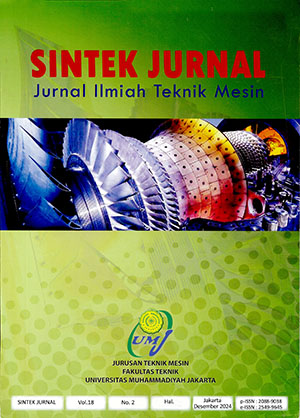Analysis of Corrosion Rate Al 7075 Using Seawater and Rainwater Media Using the K2CRO4
Main Article Content
Abstract
Article Details
- Articles published in SINTEK JURNAL are licensed under a Creative Commons Attribution-ShareAlike 4.0 International license. You are free to copy, transform, or redistribute articles for any lawful purpose in any medium, provided you give appropriate credit to the original author(s) and SINTEK JURNAL, link to the license, indicate if changes were made, and redistribute any derivative work under the same license.
- Copyright on articles is retained by the respective author(s), without restrictions. A non-exclusive license is granted to SINTEK JURNAL to publish the article and identify itself as its original publisher, along with the commercial right to include the article in a hardcopy issue for sale to libraries and individuals.
- By publishing in SINTEK JURNAL, authors grant any third party the right to use their article to the extent provided by the Creative Commons Attribution-ShareAlike 4.0 International license.
References
C. Verma, J. Aslam, R. Aslam, S. Zehra, and C. M. Hussain, Handbook of Corrosion Engineering: Mod-ern Theory, Fundamentals and Practical Applica-tions. Elsevier, 2023.
Harsimran, S. K., and R. K. Santosh, “Overview of corrosion and its control: A critical review,” Proc. Eng. Sci., vol. 3, no. 1, pp. 13–24, 2021.
S. Zehra, M. Mobin, and J. Aslam, “An overview of the corrosion chemistry,” Environmentally Sustain-able Corrosion Inhibitors, pp. 3–23, 2022.
M. Bryant and A. Neville, “Corrosion and mechani-cal properties,” Orthopaedics and Trauma, vol. 30, no. 3, pp. 176–191, 2016.
L. L. Shreir, Ed., Corrosion: Corrosion Control. Newnes, 2013.
M. Ali, A. Ul-Hamid, T. Khan, A. Bake, H. Butt, O. E. Bamidele, and A. Saeed, “Corrosion-related failures in heat exchangers,” Corrosion Reviews, vol. 39, no. 6, pp. 519–546, 2021.
K. M. Shwetha, B. M. Praveen, and B. K. Devendra, “A review on corrosion inhibitors: types, mecha-nisms, electrochemical analysis, corrosion rate and efficiency of corrosion inhibitors on mild steel in an acidic environment,” Results in Surfaces and Inter-faces, vol. 100258, 2024.
I. F. Zuñiga Tello, M. Milković, G. M. Dominguez Almaraz, and N. Gubeljak, “Ultrasonic and conven-tional fatigue endurance of aeronautical aluminum alloy 7075-T6, with artificial and induced pre-corrosion,” Metals, vol. 10, no. 8, p. 1033, 2020.
R. R. Boyer, J. D. Cotton, M. Mohaghegh, and R. E. Schafrik, “Materials considerations for aerospace applications,” MRS Bulletin, vol. 40, no. 12, pp. 1055–1066, 2015.
X. Zhang, Y. Chen, and J. Hu, “Recent advances in the development of aerospace materials,” Progress in Aerospace Sciences, vol. 97, pp. 22–34, 2018.
J. C. Williams and E. A. Starke Jr., “Progress in struc-tural materials for aerospace systems,” Acta Materi-alia, vol. 51, no. 19, pp. 5775–5799, 2003.
P. Dwivedi, A. N. Siddiquee, and S. Maheshwari, “Is-sues and requirements for aluminum alloys used in aircraft components: state of the art,” Russian Jour-nal of Non-Ferrous Metals, vol. 62, pp. 212–225, 2021.
S. Gialanella and A. Malandruccolo, “Alloys for air-craft structures,” Aerospace Alloys, pp. 41–127, 2020.
V. Osteguin, “Environmental factors affecting gal-vanic corrosion of AA7075,” Master’s thesis, The University of Texas at San Antonio, 2021.
J. G. Kaufman, Corrosion of Aluminum and Alumi-num Alloys. 2019.
K. P. Clement, “Evaluation of the effects of heat treatments on the mechanical and corrosion proper-ties of aluminum alloy 7075,” Ph.D. dissertation, The University of Tulsa, 2019.
N. S. Kumar, G. K. Pramod, P. Samrat, and M. Sa-dashiva, “A critical review on heat treatment of alu-minium alloys,” Materials Today: Proceedings, vol. 58, pp. 71–79, 2022.
T. Zhu and J. Li, “Ultra-strength materials,” Progress in Materials Science, vol. 55, no. 7, pp. 710–757, 2010.
P. A. Rometsch, Y. Zhu, X. Wu, and A. Huang, “Re-view of high-strength aluminium alloys for additive manufacturing by laser powder bed fusion,” Materi-als & Design, vol. 219, pp. 110779, 2022.
A. Liu, P. Xu, C. Gong, Y. Zhu, H. Zhang, W. Nie, and J. C. Zhou, “High serum concentration of selenium, but not calcium, cobalt, copper, iron, and magnesi-um, increased the risk of both hyperglycemia and dyslipidemia in adults: A health examination center based cross-sectional study,” Journal of Trace Ele-ments in Medicine and Biology, vol. 59, pp. 126470, 2020.
R. Kumar, S. Sharma, M. Kaundal, S. Sharma, and M. Thakur, “Response of damask rose (Rosa damascena Mill.) to foliar application of magnesium (Mg), cop-per (Cu) and zinc (Zn) sulphate under western Hima-layas,” Industrial Crops and Products, vol. 83, pp. 596–602, 2016.
H. Pan, Y. Ren, H. Fu, H. Zhao, L. Wang, X. Meng, and G. Qin, “Recent developments in rare-earth free wrought magnesium alloys having high strength: A review,” Journal of Alloys and Compounds, vol. 663, pp. 321–331, 2016.
S. S. Prasad, S. B. Prasad, K. Verma, R. K. Mishra, V. Kumar, and S. Singh, “The role and significance of magnesium in modern day research—A review,” Journal of Magnesium and Alloys, vol. 10, no. 1, pp. 1–61, 2022.
H. Yoshida, “History of the development of Extra Super Duralumin and future research issues of Al–Zn–Mg alloys,” Materials Transactions, vol. 64, no. 2, pp. 341–351, 2023.
M. M. Lachowicz, “Metallurgical aspects of the cor-rosion resistance of 7000 series aluminum alloys–A review,” Materials Science-Poland, vol. 41, no. 3, pp. 159–180, 2023.
M. Daniyal and S. Akhtar, “Corrosion assessment and control techniques for reinforced concrete struc-tures: A review,” Journal of Building Pathology and Rehabilitation, vol. 5, no. 1, pp. 1, 2020.
M. Esmaily, J. E. Svensson, S. Fajardo, N. Birbilis, G. S. Frankel, S. Virtanen, and L. G. Johansson, “Fun-damentals and advances in magnesium alloy corro-sion,” Progress in Materials Science, vol. 89, pp. 92–193, 2017.


